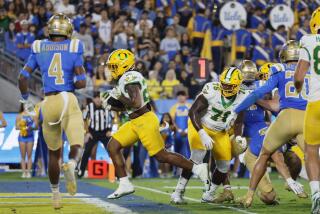PACIFIC 10 BASKETBALL / DAN HAFNER : Beavers’ Road Takes Turn for Better
- Share via
Oregon State fans and alumni were grumbling when the Beavers, with high expectations, stumbled on the road early in the season.
“There’s nobody up here unhappy now,” Coach Jim Anderson said from Corvallis this week after the Beavers’ fast start in Pacific 10 Conference play. They won on the road at Stanford and California last week.
The Beavers, who can take a giant step toward the conference title if they win home games against USC tonight and UCLA on Saturday, lost all five road games before their sweep in the Bay Area.
After the Beavers lost all three games on an Eastern swing in December, they were booed by fans at the Far West tournament in Portland.
“Before the season started, I felt we needed tough games on the road,” Anderson said. “But as the going got rougher, I began to doubt the wisdom. Now, I know it was the right move, and so does everybody else.
“We fell behind in both games last week, but I could see by the players’ attitudes that there was no panic.”
In three of the defeats, center Scott Haskin, the Beavers’ best player, was in early foul trouble and played less than half of each game.
“His loss in games at Southwest Missouri and James Madison cost us any chance we had of winning,” Anderson said. “But we had a lead against North Carolina State, (then) panicked. The lesson we learned in that game enabled us to hang in there against Cal and Stanford.
“We can’t get overconfident, though, because it will be extremely difficult to beat both USC and UCLA, even at home.”
Before conference play began, it was thought that because there was no standout in the Pac-10, winning on the road would be difficult. In the first week, visiting teams won five of the nine games.
Arizona probably profited the most. The Wildcats, seeking their fourth title in six seasons, moved into the favorite’s role with two victories in Los Angeles.
“There isn’t an easy trip in the conference this season,” Coach Lute Olson said, “but the one to L.A. this season figured to be the most difficult. Both are picked in the top five, so getting out with two victories gives us a big jump.
“Of the nine players in our rotation, four are freshmen and two are sophomores. When I saw the schedule, I was thinking that we would be better off making that trip later in the season.
“But our young players came through, and I give credit to Chris Mills. He has been our leader both on and off the court. With all the young players, this is the first time in a long time that we needed a leader off the court, too. Chris has stepped forward and done the job.”
Last season, the Wildcats came down to the last two games needing victories at UCLA and at USC to tie for the Pac-10 title. They came away empty-handed.
When Brent Barry stepped to the free-throw line with 15 seconds to play at Berkeley last Saturday, needing to make both attempts to give Oregon State the victory, the crowd gasped.
Barry, a son of former NBA star Rick Barry, was shooting underhanded, using both hands. He swished both shots.
This style of free-throw shooting has almost disappeared from the sport. But it should not have come as a real surprise. Barry’s father, one of the best from the free-throw line, used the same method and taught it to his sons.
For years under longtime coach Slats Gill, all the Beavers shot free throws underhanded.
“It wasn’t until 1959 that Slats finally started to relent,” recalled Anderson, who played for Gill at Oregon State.
“People who see Brent for the first time often think it’s a joke when he steps to the line. But BYU didn’t see anything funny about it when he was 12 for 12.”
Barry is the Pac-10’s free-throw leader, making 23 of 26 for 88.5%.
Pacific 10 Notes
USC Coach George Raveling was chosen as one of the “five most intriguing people of 1992” in basketball by Basketball Times. . . . The three top scorers in the conference are averaging more than 20 points and all play for Arizona teams. Chris Mills leads with a 21.6-point average. He is trailed by Stevin Smith (20.7) and Dwayne Fontana (20.6), both of Arizona State. . . . Mills, Marcell Capers of Arizona State and Phil Glenn of USC are the top three in three-point shooting. Mills is shooting 52.6%. . . . Although he and his California teammates have been struggling after a fast start, freshman Jason Kidd leads in steals with 32 in nine games.
More to Read
Go beyond the scoreboard
Get the latest on L.A.'s teams in the daily Sports Report newsletter.
You may occasionally receive promotional content from the Los Angeles Times.










